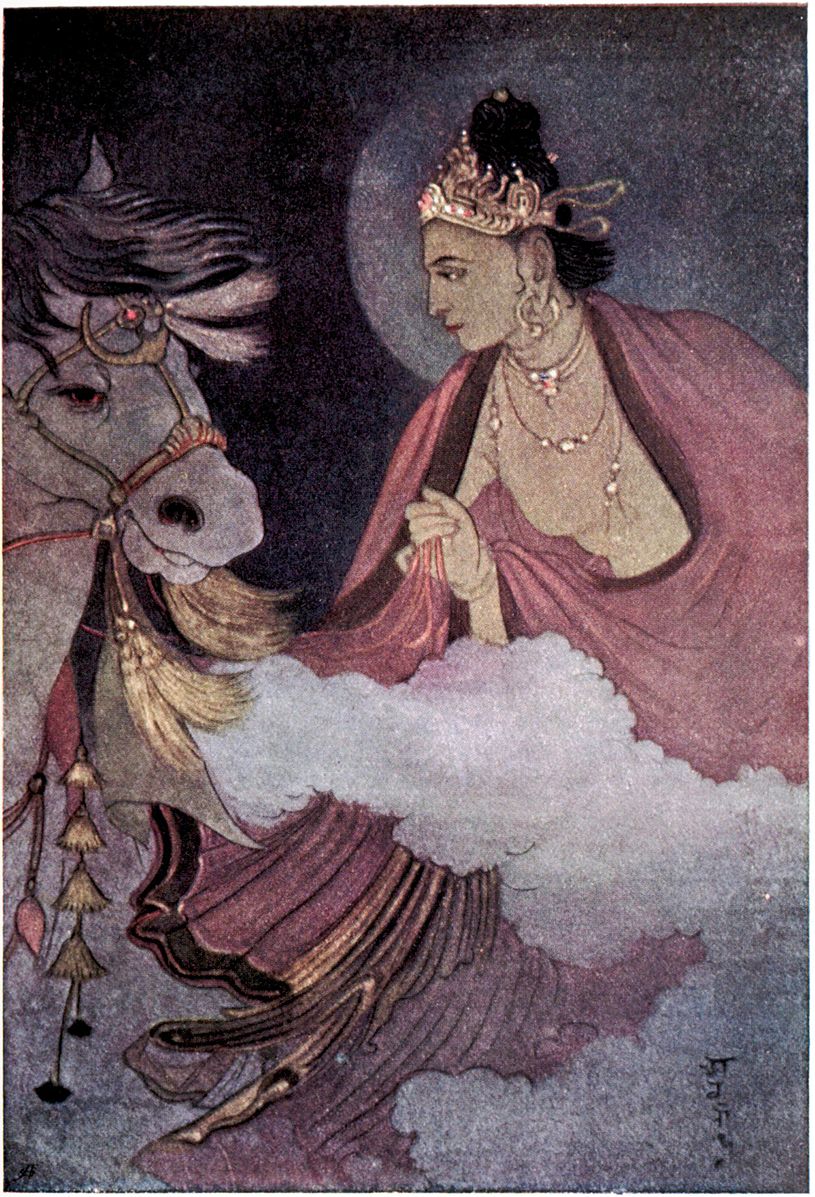Who was the Buddha?
Before the Buddha became the Buddha, or “the enlightened one,” he was Prince Siddhartha Gautama. Five important moments mark Siddhartha Gautama’s life before he became the Buddha: his birth, renunciation of his life as a prince, enlightenment, first sermon, and his death.
Art about Siddhartha and his human life features these major scenes, each of which incorporates special marks and symbols to identify the specific moment.
1. Birth
Detail from The Life of the Buddha: The Birth of the Buddha. Early 15th century CE. Muromachi. The Met.
The Buddha was born in the city of Lumbini, in modern-day Nepal.
His mother, Queen Maya, had a dream that a white elephant entered her womb through her right side. She was visiting her parents when she stopped in the Lumbini Grove, where she held onto a branch of a shala tree and gave birth to Prince Siddhartha, who, according to legend, emerged from her right side.
Birth of the Buddha Sakyamuni. 2nd century. Kushan. Gandhara. The Met.
2. The Great Renunciation and the Departure
Prince Siddhartha grew up surrounded by luxury and privilege. Due to his father's protection and care, for the first part of Siddhartha's life, he wanted for nothing. Because he wanted for nothing, he also knew nothing about suffering.
Departure of Prince Siddhartha, illustration from 'Myths of the Hindus and Buddhists' by Sister Nivedita and Ananda Coomaraswamy, 1st edition, 1913. Abanindranath Tagore. 1913. Calcutta.
One day, he ventured out into the world and came across an old man, a sick man, a dead man, and an ascetic, in a series of meetings known as “the Four Encounters.” The sight of their pain struck deeply inside Siddhartha and he began to seek a way to end suffering.
One day, he made the choice to leave his life of luxury. In the dead of the night, he rode with his horse to Rajagaha, where he removed all his royal clothes and jewels to leave with his chariot driver to send back to his father.
The Great Departure. 100-70 BCE. East Gate of Stupa #1 at the Sanchi Temple in Madhya Pradash, India. Wiki Commons, Michael Gunther.
In art, he is depicted riding out of his city on his horse Kanthaka, accompanied by only a chariot driver, Channa.
In this narrative Sanchi relief, the Buddha is symbolized by a parasol hovering over his horse. By the time the horse reaches the furthermost right side of the relief, the Buddha has cast off his worldly trappings. This is indicated by his two footprints. The horse returns to the palace, this time without the parasol.
Image edited to highlight the Buddha's presence.
3. Enlightenment
Plaque with Scenes from the Life of the Buddha. 12th century. Pala. Bihar, India. The Met.
The Buddha meditated under a pipal tree (also known as a Bodhi tree) for forty days. Mara, the god of death and destruction, sent various temptations and armies of demons to distract Siddhartha Gautama during his meditation. But when Mara's soldiers tried to attack Siddhartha, their weapons would turn into flowers.
Mara's Retinue, Folio from an Ashtasahasrika Prajnaparamita (The Perfection of Wisdom in 8,000 Verses). 11th century. Nepal. LACMA.
With the his army of demons behind him, Mara asked Siddhartha, "Who said you could reach enlightenment? Who let you?"
"Who let you?" roared the army of demons, echoing their leader.
At that moment, Siddhartha extended his hand and gently touched the ground, and the earth responded for him, "I do. I bear witness to Siddhartha's sincerity."
With the Earth standing on Siddhartha's side, Mara was defeated.
Akshobhya, the Buddha of the Eastern Pure Land. 16th-17th century. Nepal. The Met.
Art representing the moment of the Buddha's enlightenment usually depicts the Buddha with his hand touching the earth. This hand gesture, or mudra, is called the Bhumisparsa Mudra.
4. The First Sermon
Detail from Book Cover of Manuscript of the Ashtasahasrika Prajnaparamita Sutra. 10th-11th century. Thakuri-Malla. Nepal. The Met.
After his enlightenment, the Buddha wanted to share his discoveries. He gave his first sermon at the Deer Park in Sarnath. His hands are often shown in the Dharmachakra Mudra to indicate that he is teaching.
The wheel represents his teachings about samsara, the cycle of birth and rebirth and, thus, suffering in life. There are also usually deer present in the images that represent this scene to indicate the sermon’s location.
Buddha's First Sermon at Sarnath. 2nd century CE. Gandhara. The Met.
5. Death
The reclining Buddha in Cave 158, 781-848 CE, Dunhuang. Photo by Wu Jian. Image courtesy of the Dunhuang Academy.
Siddhartha Gautama died at the age of eighty. It is said that he lay on his right side beneath shala trees (the same trees under which he was born) in the city of Kushinagara as his soul left his body to enter nirvana.
When the Buddha became enlightened under the bodhi tree, he did reach nirvana, but it was a partial state of nirvana, because he still needed to live out the rest of the mortal life of Siddhartha Gautama. With the death of this body, the Buddha finally entered the state of complete nirvana, or parinirvana.
Mural at the foot of the reclining Buddha in Cave 158, 781-848 CE, Dunhuang. Photo by Wu Jian. Image courtesy of the Dunhuang Academy.
In art, the reclining Buddha is surrounded by bodhisattvas, kings, and disciples who mourn his death.
Further reading
On the life of the Buddha:
On Buddha hand gestures, or mudras:
On Mara:
On parinirvana:












